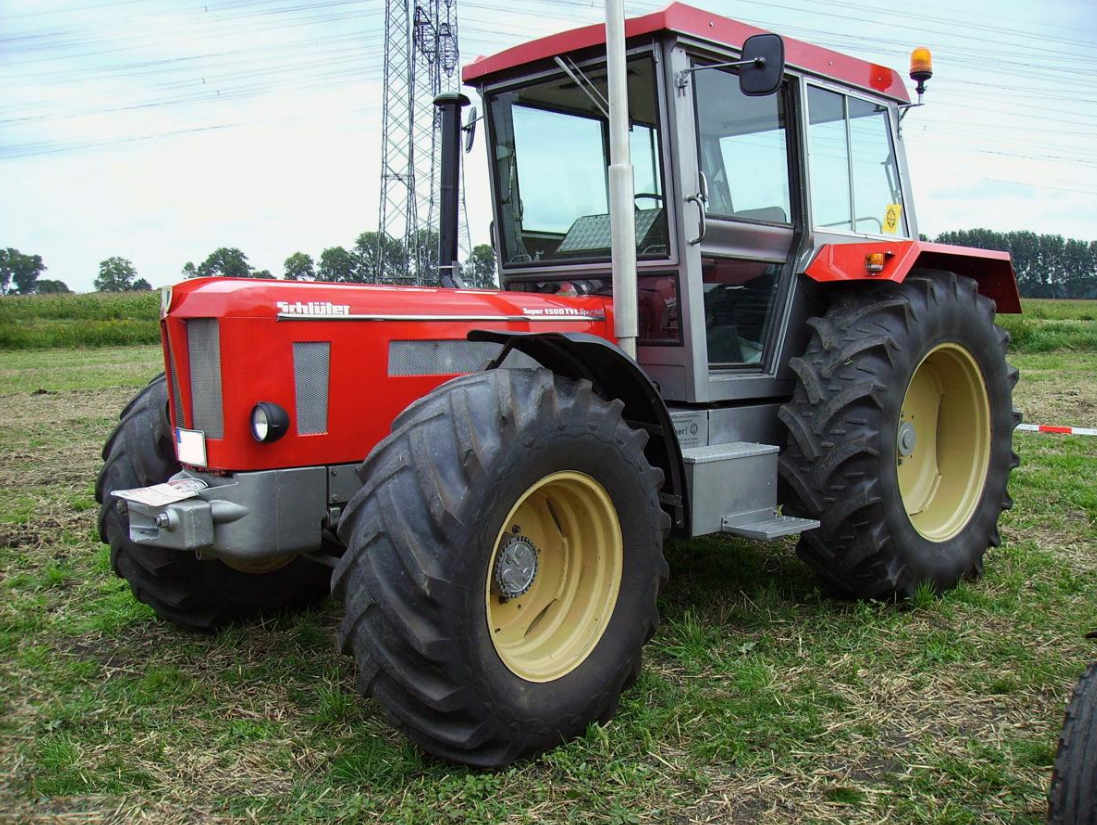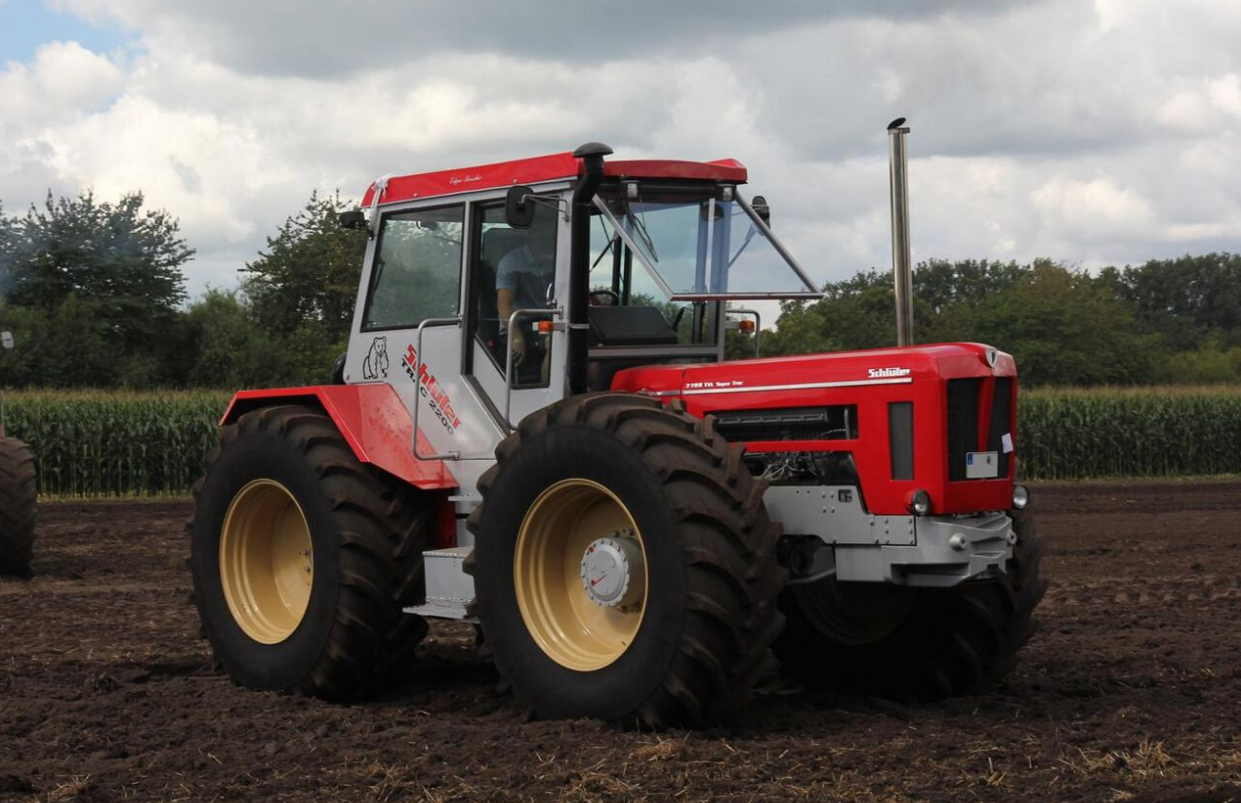
| Version | Summary | Created by | Modification | Content Size | Created at | Operation |
|---|---|---|---|---|---|---|
| 1 | Dean Liu | -- | 1228 | 2022-11-01 01:33:17 |
Video Upload Options
Anton Schlüter München (also spelled: Anton Schlueter Muenchen) was a Germany tractor manufacturer in the region of Munich, Bavaria. Amongst farmers and tractor enthusiasts, this brand is usually known simplified, as Schlüter (also spelled: Schlueter).
1. History
The company Anton Schlüter München was founded in 1898, by councillor of commerce (German: Kommerzienrat) Anton Schlüter. In the beginning, the primary objective of the company was the production of gasoline engines and multi-fuel engines. Twelve years after the foundation of the company, Anton Schlüter acquired his own foundry. It was located in Freising, a town near Munich. In 1910, new buildings were constructed by the architects Jakob Heilmann and Max Littmann. After one more year, Schlüter built a test area, the so-called Schlüterhof.
2. Tractor Building


In 1937, Schlüter launched the production of tractors. Because the Second World War caused a lack of gasoline, upon the year 1942 there were also produced tractors and generators powered by wood gasifiers within a power range of 25 to 50 hp. Caused by air raids, dedicated to Munich and Freising, most of the plant in Munich and the foundry in Freising were destroyed by bombs. When Anton Schlüter (junior) took over business after the death of his father in 1949, he decided not to rebuild the facilities in Munich. Instead of Munich and Freising, the whole company was moved to Freising. Freising was the only place where the headquarters and all compartments of production were concentrated. Since the year 1964, Schlüter was specialized in tractors of the upper power range. At that time, that meant engines till 320 hp. Quite an exception in that era were tractors which obtained four tires of the same size, represented by the Super Trac series. The Profi Trac series were equipped with four equally sized tires, mounted on two steerable axles instead of just one. The rear axle of the Profi Trac could steer in the opposite or same direction as the front axle, as well as not steering at all. In 1978, a unique specimen was built, the so-called Profi Trac 5000 TVL with 500 hp. At its appearance, it was regarded as the most powerful tractor in Europe. One reason for the construction of this tractor was an order from the former Yugoslavian president Tito. But the idea of a series production of this type was cancelled, caused by political changes in former Yugoslavia. Nowadays, the only existing specimen of a Profi Trac 5000 TVL is possessed by a private person. In 1989, Schlüter presented a new line of products. Its name was Euro Trac. Specific for these new tractors were its driver's cab in the middle of both axles, together with relocatable ballast weight, placed on top of the front axis. More or less, this tractor was almost similar to the MB-trac. Despite of this latest development, the brand competition amongst tractor producing companies was rough at that time. Schlüter suffered on a technical delay in those years. Furthermore, one of the results of the German Reunification was that the demand of so-called system tractors (German:Systemtraktoren). The specialist term system tractors describes tractors, which offer a third or fourth opportunity to fix machines or containers, like above the front or the rear axle. For instance, the MB-trac or Fendt GT were considered as system tractors, also the Unimog or the Fastrac. Generally, the demand of such tractors became lower, while more powerful standard tractors were required. As a result of all those contemporaneous circumstances, only 184 Euro Trac were built until the Schlüter company went bankrupt.
3. Type Series
Until the end of production in Freising, there were mainly three different lines of tractors, which are worth to be named:
“Super” and “Compact” were standard tractors
“Super Trac”, a tractor with same-size tyres
“Profi Trac”, a tractor with same-size tyres and two steerable axles
“Euro Trac”, the latest development of the company
4. Peculiarities
The Schlüter emblem consists of a bear, with a letter S in its front. The letter S stands for Schlüter whilst the bear signifies endurance, power and heavy duty working ability. Ahead of the bonnet there is a coat of arms. It contains the lettering Schlüter, below of it there is an area, divided in white and blue.
A recognition mark of Schlüter was the scheme of colouring. Since the 1960 years, there were two dominating colours: Silver for the chassis and parts of the driver's cab, red colour for all parts made of sheet metal (engine hood, fenders, roof). The wheels of a huge number of Schlüter tractors obtained a further colour. It had been khaki until it was substituted by silver, which occurred in the late 1980 years.
Quite an advantage of Schlüter was the very good accessibility of motor, gearbox and both axis. This was facilitated by a hydraulically pivoting driver's cab and a hinged engine bonnet.
One more singularity was the distinctive design of the driver's cab. The windscreens were inclined in the opposite sense, similar to the driver's platform of a combine harvester. The rear screen was even more inclined than on any other “usual” tractor. Another characteristic mark were the sliding doors of the cabin on left and right side. At the time of first presentation, this driver's cabin was quite distinctive to all those ones of other contemporaneous tractors.
5. Shutdown of the Establishment
In December 1993, Schlüter finished its production at the plant in Freising. But except of all the other series of Schlüter tractors, the Euro Trac series should be continued. Therefore, another company showed its interest. With Landtechnik Schönebeck, a manufacturer of agricultural machinery in the former German Democratic Republic, the Euro Trac was produced in eastern Germany. Even there, only 32 Euro Trac had been built. Then, there was still a further company which took over the Euro Trac from Landtechnik Schönebeck: Until 2004, some more Euro Trac were produced by Egelseer, located in Fürth (a town close to Nuremberg). Today, the Egelseer company is the general supplier of spare parts and also an advisor in any technical matters which are referring to Schlüter tractors.
The closed factory facilities of Schlüter in Freising were unused for more than ten years. Because of its age and its former signification, the former Schlüter buildings were considered and declared as a cultural heritage. Then, the hangars were renovated and changed in their determination. Nowadays they are used as a shopping mall. There, a Schlüter tractor took place as a reminding monument of the former utilization of the buildings.
Anton Schlüter himself died in summer of the year 1999. Up to now, there is a large number of Schlüter fan clubs in Germany and other countries. They pay tribute to the Schlüter brand, to its remarkable history and to the tractors of Schlüter. One of the activities of these clubs is the arrangement of reunion events. Furthermore, many Schlüter tractors enjoy a high appreciation by their fans. Nowadays, a large number of the remained tractors are regarded as an individual value, repaired and maintained very well. So, the memory of Anton Schlüter München will not be forgotten but remain for a long time.




